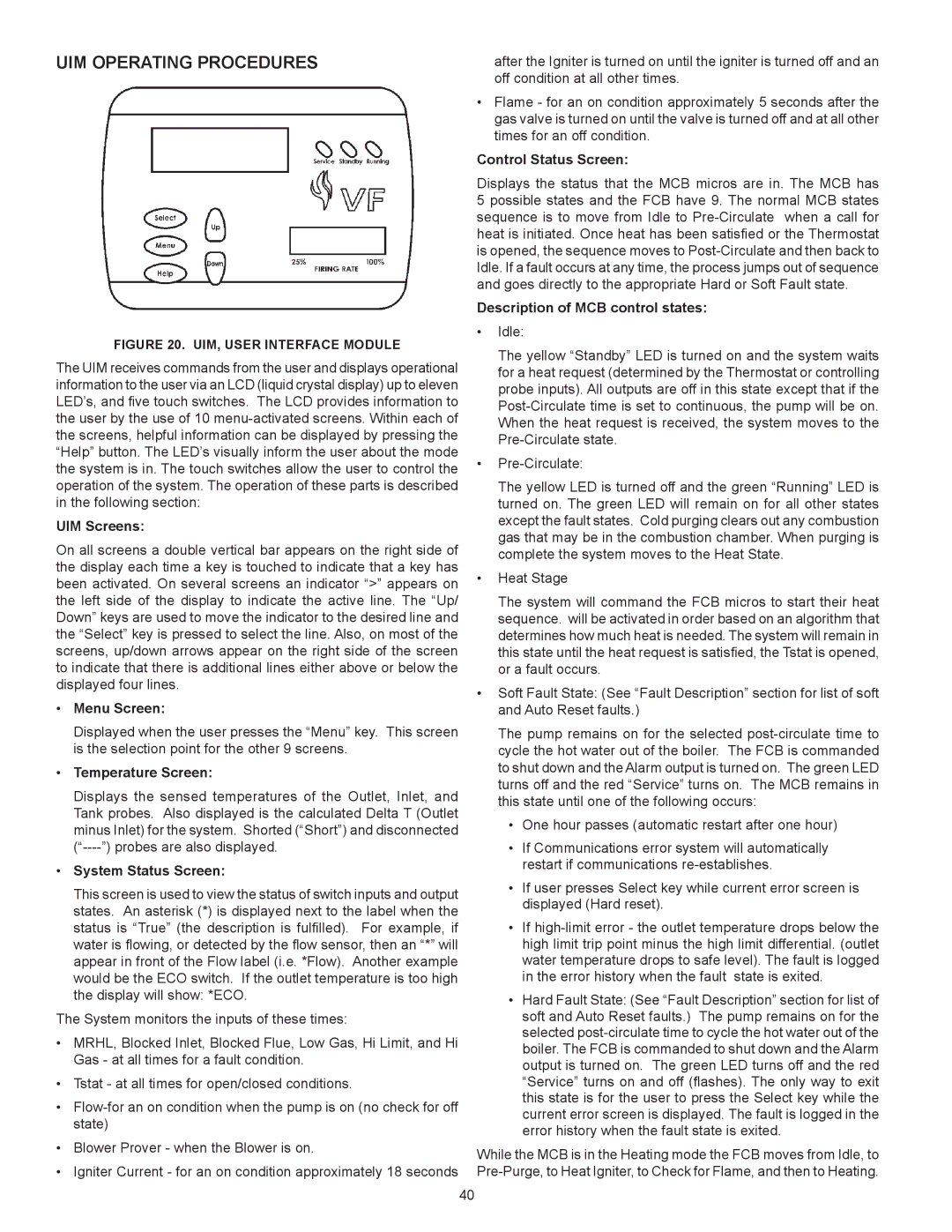UIM Operating Procedures
FIGURE 20. UIM, USER INTERFACE MODULE
The UIM receives commands from the user and displays operational information to the user via an LCD (liquid crystal display) up to eleven LED’s, and five touch switches. The LCD provides information to the user by the use of 10 menu-activated screens. Within each of the screens, helpful information can be displayed by pressing the “Help” button. The LED’s visually inform the user about the mode the system is in. The touch switches allow the user to control the operation of the system. The operation of these parts is described in the following section:
UIM Screens:
On all screens a double vertical bar appears on the right side of the display each time a key is touched to indicate that a key has been activated. On several screens an indicator “>” appears on the left side of the display to indicate the active line. The “Up/ Down” keys are used to move the indicator to the desired line and the “Select” key is pressed to select the line. Also, on most of the screens, up/down arrows appear on the right side of the screen to indicate that there is additional lines either above or below the displayed four lines.
•Menu Screen:
Displayed when the user presses the “Menu” key. This screen is the selection point for the other 9 screens.
•Temperature Screen:
Displays the sensed temperatures of the Outlet, Inlet, and
Tank probes. Also displayed is the calculated Delta T (Outlet minus Inlet) for the system. Shorted (“Short”) and disconnected (“----”) probes are also displayed.
•System Status Screen:
This screen is used to view the status of switch inputs and output states. An asterisk (*) is displayed next to the label when the status is “True” (the description is fulfilled). For example, if water is flowing, or detected by the flow sensor, then an “*” will appear in front of the Flow label (i.e. *Flow). Another example would be the ECO switch. If the outlet temperature is too high the display will show: *ECO.
The System monitors the inputs of these times:
•MRHL, Blocked Inlet, Blocked Flue, Low Gas, Hi Limit, and Hi
Gas - at all times for a fault condition.
•Tstat - at all times for open/closed conditions.
•Flow-for an on condition when the pump is on (no check for off state)
•Blower Prover - when the Blower is on.
•Igniter Current - for an on condition approximately 18 seconds
after the Igniter is turned on until the igniter is turned off and an off condition at all other times.
•Flame - for an on condition approximately 5 seconds after the gas valve is turned on until the valve is turned off and at all other times for an off condition.
Control Status Screen:
Displays the status that the MCB micros are in. The MCB has 5 possible states and the FCB have 9. The normal MCB states sequence is to move from Idle to Pre-Circulate when a call for heat is initiated. Once heat has been satisfied or the Thermostat is opened, the sequence moves to Post-Circulate and then back to Idle. If a fault occurs at any time, the process jumps out of sequence and goes directly to the appropriate Hard or Soft Fault state.
Description of MCB control states:
•Idle:
The yellow “Standby” LED is turned on and the system waits for a heat request (determined by the Thermostat or controlling probe inputs). All outputs are off in this state except that if the
Post-Circulate time is set to continuous, the pump will be on. When the heat request is received, the system moves to the Pre-Circulate state.
•Pre-Circulate:
The yellow LED is turned off and the green “Running” LED is turned on. The green LED will remain on for all other states except the fault states. Cold purging clears out any combustion gas that may be in the combustion chamber. When purging is complete the system moves to the Heat State.
•Heat Stage
The system will command the FCB micros to start their heat sequence. will be activated in order based on an algorithm that determines how much heat is needed. The system will remain in this state until the heat request is satisfied, the Tstat is opened, or a fault occurs.
•Soft Fault State: (See “Fault Description” section for list of soft and Auto Reset faults.)
The pump remains on for the selected post-circulate time to cycle the hot water out of the boiler. The FCB is commanded to shut down and the Alarm output is turned on. The green LED turns off and the red “Service” turns on. The MCB remains in this state until one of the following occurs:
•One hour passes (automatic restart after one hour)
•If Communications error system will automatically restart if communications re-establishes.
•If user presses Select key while current error screen is displayed (Hard reset).
•If high-limit error - the outlet temperature drops below the high limit trip point minus the high limit differential. (outlet water temperature drops to safe level). The fault is logged in the error history when the fault state is exited.
•Hard Fault State: (See “Fault Description” section for list of soft and Auto Reset faults.) The pump remains on for the selected post-circulate time to cycle the hot water out of the boiler. The FCB is commanded to shut down and the Alarm output is turned on. The green LED turns off and the red
“Service” turns on and off (flashes). The only way to exit this state is for the user to press the Select key while the current error screen is displayed. The fault is logged in the error history when the fault state is exited.
While the MCB is in the Heating mode the FCB moves from Idle, to Pre-Purge, to Heat Igniter, to Check for Flame, and then to Heating.

